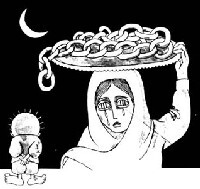Khan Younis, Palestine 22 August 2002

Naji al-Ali
On walls throughout the Gaza Strip, graffiti, in bold strokes of red, green and black expresses Palestinian anger and frustration: ‘Continuous Intifada until independence and the right of return.’
Naive, simple lines depict a Hamas operation in Eli Sinai settlement in the north of the Strip: masked Hamas fighters storming the settlement, the fence torn down, houses burning, and the fighters victorious.
Another painting, childishly graphic, shows a settler bus, blown apart, skulls flying from the windows. It faces onto the busy marketplace in Khan Younis, a macabre backdrop to everyday life: a donkey, part of the chaotic mess of traffic, trots past pulling a cart of giggling children, and women saunter along the road clutching bags of vegetables.
The walls lining the roads near the home of Muhammad Al-Dura are wallpapered in paintings of the child clutching his father, the familiar image broadcast worldwide. Underneath one such painting are the words, ‘what was taken by force, can only be returned by force.’
But he is not alone; every street has faces of the dead, emblazed on a backdrop of Jerusalem. On one wall of the refugee camp there is a mural, a painted war memorial. Three long columns list the names of the dead, beneath the words, ‘The Street of the Martyrs.’
Handalah, the Palestinian refugee. Naja Al-Ali’s famous character, a refugee in Lebanon, always facing towards Palestine, in his tattered trousers and spiky hair: adorning the corner of Omar Al-Mukhtar street in Gaza City.
The images and slogans are given to shebab on bits of paper. Armed with buckets of whitewash and paint, politics is continually rewritten and re-expressed: one image inspiring the other in this seemingly endless, sad cycle of blood and tears.

